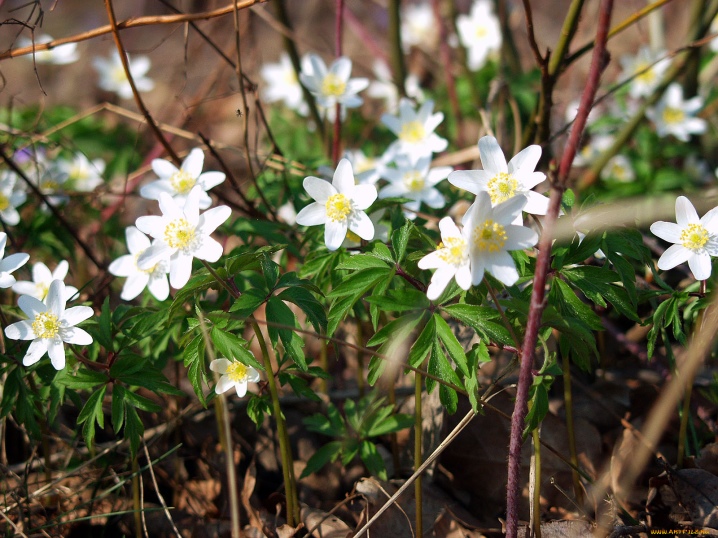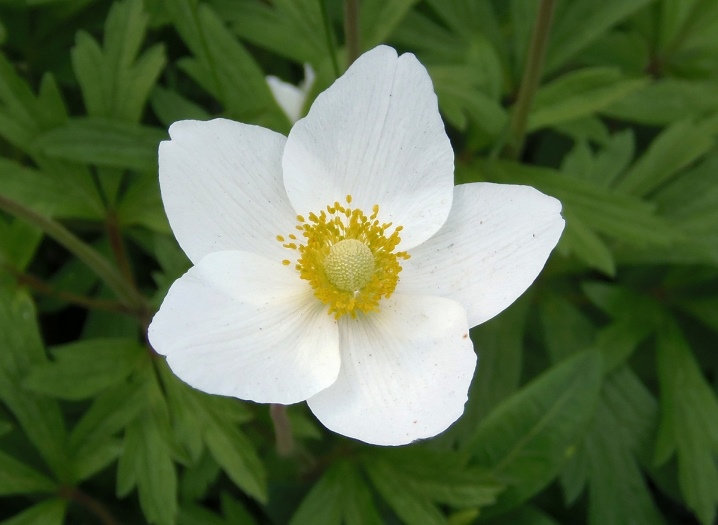White anemones: an overview of varieties and cultivation

The legend about the appearance of white anemones is sad - according to legend, the tears of Aphrodite, mourning Adonis, turned into these flowers. In total, about 170 species of anemone are known - inhabitants of coniferous and deciduous forests. Now in decorative floriculture, garden flowers are used, specially bred varieties of anemones, among which I would like to highlight the group of terry anemones, especially lush during flowering.


Varieties
Noble coppice
In deciduous forests from Scandinavia to Korea, you can see a perennial noble copse. Its flowers can be white, blue, pink, purple. Peduncle and leaves sprout directly from the rhizome. The copse is bred as an ornamental plant.

Tender anemone
Anemone prefers coniferous forests and mountains as habitats. Thin stems appear from the buds in spring. The plant lives up to its name - charming delicate flowers appear in early May. Breeders have bred many different colored varieties. White Splender and Bridesmaid are white, Charme is a pink anemone with a white center. Radar also has a white center, and its petals are dark red.

Blue anemone
Despite the very specific name, it can be white. Originally from the south of Western Siberia. The plant is short and small. In height, it rises to 20 cm, the diameter of the flower is about 2 cm. The beginning of flowering is mid-May.


Anemone oakravnaya
The forest flower anemone is known to all European amateur botanists. In natural conditions, white flowers are often found. Decorative options for oak anemone are more than 30 varieties. Terry snow Vestal is very popular, often gardeners strive to grow Lucys Wood or Alba Plena.

Forest anemone
Uncomplicated, five-petal, like a flower from a child's drawing - forest anemone. Her flowers are quite large, pure white, and the underside is sometimes with a faint purple tint. Primrose prefers thickets of bushes and forest edges. The anemone has taken root in the gardens for a very long time, since the XIV century.
Of course, now the choice of varieties is much richer: Fruhlingszauber and Macrantha will surprise you with large flowers, and Wienerwald and Elise Feldman (Plena) will delight you with the splendor of double buds.

Rock anemone
The homeland of anemone is the Himalayas, while he is an infrequent visitor to summer cottages. And in vain - the anemone is unpretentious in care, and its flowers look very impressive. On the back of the snow-white petals, an ink-colored bloom is present. The height of the anemone is up to 30 cm.

Udskaya anemone
One of those rare plants that you can plant and forget for a while. This species is valued not for its small white flowers, but for its unusual leaves and growth rate. The dense green carpet of the Ud anemone practically does not require attention.

Baikal anemone
A perennial anemone that feels great both in the thicket of the forest and in the thickets of garden shrubs. Demanding on moisture and soil composition. In nature, this species is a Sayan-Baikal endemic listed in the Red Book.
White flowers are small, against the background of dense greenery, they look very touching and delicate.

Drummord Field Anemone
Another representative of the flora of North America, where it grows on the rocky slopes of the mountains. The flower is poppy-shaped, white. There may be a blue or greenish tint on the underside of the petals. The stem is short, the leaves are small.

Anemone Wölwind
Anemone Völwind is the name of both the species and one of the most popular varieties in this species.Numerous shoots reach a height of 80 cm and culminate in a beautiful white flower with a golden core. The beauty and ease of growing is the secret to the popularity of the Whirlwind strain.


Crown anemone
Quite tall perennials. The richest species of anemones in colors and shades. Large, up to 10 cm in diameter, flowers can be both snow-white and deep blue. Moreover, these flowers appear in many representatives of the species twice a season: in early summer and autumn. Mount Everest blooms white buds.
Bicolor anemones look very elegant - white with bright red edging.

Planting and leaving
There are 4 options for breeding anemone: with the help of seeds, dividing the bush, reproduction by parts of rhizomes and tubers. Despite the sophistication of the plant, it is quite simple to care for it. The main thing is timely watering and maintaining the desired moisture level in the open field. To make it easier to create the optimal one, it is recommended to plant flowers in an area with good drainage, which is located on a hill. Excess moisture is destructive for anemones, rot appears on the roots. It is better to cover the planted anemones with a layer of mulch 5 cm thick.


In the spring, anemones are watered about once a week. In the summer - depending on the circumstances. If the summer is rainy, then additional watering may not be needed. It is necessary to regularly loosen the soil and remove weeds, and these actions must be performed very carefully, since the root system of anemones is fragile.
When the anemone blooms, it is fed with organic fertilizers, and in the fall - with complex mineral fertilizers.
You can take a closer look at the white anemones further.





































































































The comment was sent successfully.